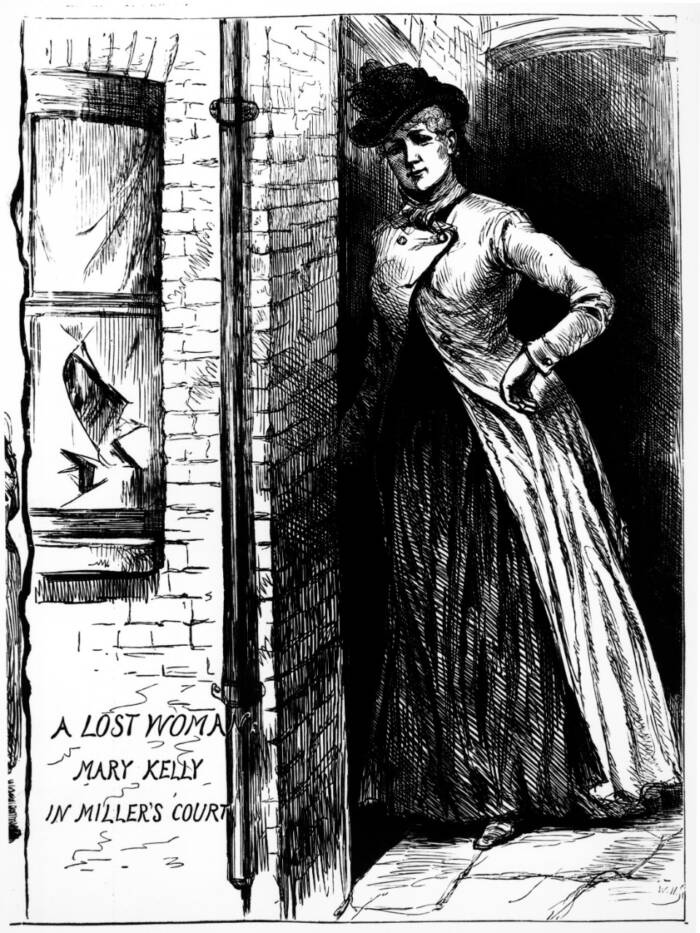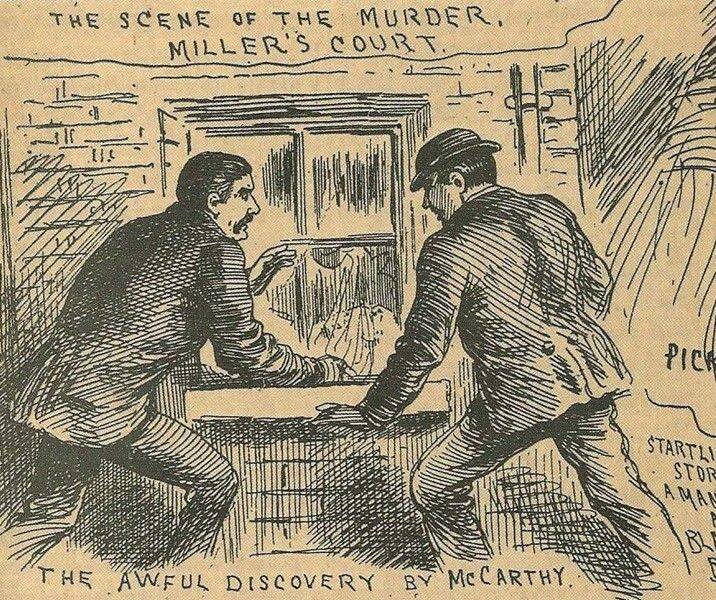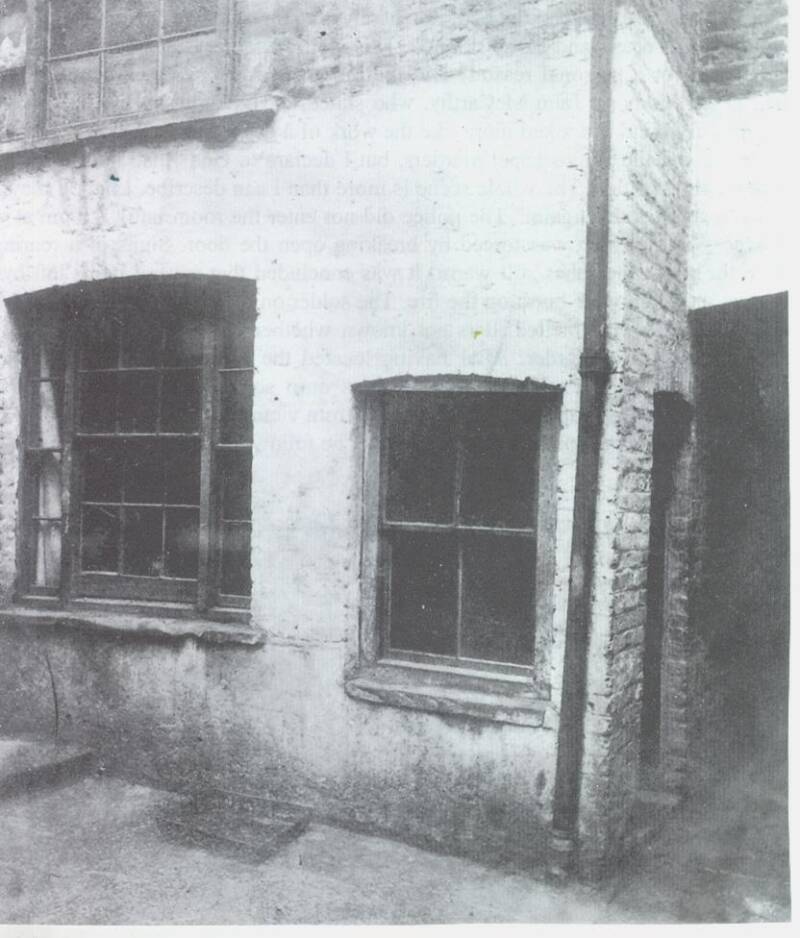Mary Jane Kelly was an enigmatic figure with a mostly unverified story. What was clear, though, was the horrifying nature of her murder.

Wikimedia CommonsThe mangled corpse of Mary Jane Kelly.
Jack the Ripper’s last victim was as mysterious as the notorious serial killer himself. Mary Jane Kelly, generally considered the fifth and final victim of the Victorian serial killer, was found dead on November 9, 1888. But little of Mary Jane Kelly’s life is known — and even then, it is nearly impossible to verify any of it.
Even her name was something of a mystery. In addition to Mary Jane Kelly, she went by Maria Jeanette Kelly, Fair Emma, Ginger, Dark Mary, and Black Mary. There is little documentary evidence to confirm — or disprove — any claims about Kelly’s life, most of which come from her last lover, Joseph Barnett.
What can be confirmed is that Mary Jane Kelly’s mutilated body was discovered in a room she leased on Dorset Street in East London in the Spitalfields area, a slum frequently occupied by prostitutes and criminals. She is considered the final canonical victim of Jack the Ripper, and her murder was certainly the most gruesome.
Mary Jane Kelly’s Murky Beginnings
Much of the information on Mary Jane Kelly’s background comes from Joseph Barnett, her most recent lover before her death.
He shared what Kelly had told him of her life, but that isn’t saying much, given that Kelly herself was a rather untrustworthy narrator. Her stories are full of contradictions and embellishments, which have, over the years, been subjected to a long-running game of telephone. Still, Barnett’s account of Kelly’s life is the only direct source of information on her.

Public DomainAn illustration of Mary Jane Kelly in the November 24, 1888 edition of the Penny Illustrated Paper.
According to Barnett, Kelly was born in Limerick, Ireland around 1863. She never gave the exact date of her birth, nor did she clarify if she was referring to Limerick, the city or Limerick, the county. In either case, the Kelly family moved to Wales when Mary Jane was a child.
Her father was supposedly an ironworker named John Kelly, and details of her mother are unknown. One of six or seven siblings, she moved to Wales with her family when she was a child.
To one acquaintance, Kelly claimed that her parents had disowned her — why, no one knows — but that she remained close to her sister. To Barnett, Kelly said her family had been moderately wealthy, and her landlord confirmed that she would occasionally receive letters from someone in Ireland.
Kelly later moved to Cardiff, following the death of her husband, a coal miner with either the last name Davis or Davies. With no financial support, she lived with her cousin for a time and began selling herself on the streets. Then, in 1884, she made her way to London where, according to Barnett, she worked at an upscale brothel.

Public DomainA November 17, 1888 Illustrated Police News sketch depicting the discovery of Mary Jane Kelly’s body.
Conflicting claims also suggested that Kelly had been an intelligent and scholarly woman, while others insinuated that she may have in fact been illiterate.
Even trying to get an understanding of what Mary Jane Kelly looked like can be difficult from a historical perspective. She was reportedly either blonde or red-headed, but given the nickname “Black Mary,” she could have just as likely had dark hair. That said, she also had the nickname “Ginger,” so it really isn’t possible to say which was true.
As author R. Michael Gordon writes in his book, Alias Jack the Ripper, A reporter from the Press Association said that a friendship with a French woman from the affluent Knightsbridge neighborhood was the catalyst that led to Kelly’s death.
Kelly and the French woman would “drive about in a carriage and made several journeys to the French capital, and, in fact, led a life which is described as that ‘of a lady.'”
But for some reason, and it’s unclear why, Kelly wound up drifting into the dodgier East End.
Mary Jane Kelly’s Relationship With Joseph Barnett
Mary Jane Kelly allegedly started drinking heavily once she moved to the East End and found herself living with a married couple for a few years. She left to live with one man — and then another man.
An anonymous prostitute reported that in 1886, Mary Jane Kelly was living at a Cooley’s Lodging House, a cheap home where multiple people typically share rooms and common spaces, in Spitalfields when she met 28-year-old fish porter Joseph Barnett.

Wikimedia CommonsThe room at 13 Miller’s Court where Mary Jane Kelly would meet her tragic end.
She had only met Barnett twice when the two decided to move in together on April 9, 1887. They were kicked out of their first place in Little Paternoster Row, however, for not paying rent and for getting drunk, and moved to the fatal room on Dorset Street: 13 Miller’s Court. It was dirty and damp, with boarded up windows and a padlocked door.
What happened after the move to Dorset Street is even murkier. It’s said that Kelly was no longer prostituting herself, but when Barnett lost his job, she returned to it. When Kelly wanted to share the room with a fellow prostitute, she got in a fight with Barnett over it, and he subsequently left.
Although Barnett no longer lived with Kelly, though, he did visit her frequently. And tragically, he had even been with her the night before her tragic demise thanks to Jack the Ripper, who had already murdered four women: Mary Ann Nichols, Annie Chapman, Elizabeth Stride, and Catherine Eddowes.
The Gruesome Murder Of Mary Jane Kelly At The Hands Of Jack The Ripper
On November 8, 1888, Barnett visited Kelly for the last time. He stayed with her for roughly an hour, between 7:00 p.m. and 8:00 p.m., while she was spending time with a friend named Maria Harvey. Barnett occasionally would give Kelly money during his visits, but on this night he had none to give.

He and Harvey left the apartment around the same time, with Barnett returning to his lodging house to play cards until roughly 12:30 a.m. Shortly after, Mary Jane Kelly was seen at the Ten Bells public house with another woman, Elizabeth Foster, and she was later seen drinking with two others at the Horn of Plenty pub on Dorset Street.
Her whereabouts for the rest of the evening are largely unknown. Some say they saw her drunk with another prostitute at around 11:00 p.m., and a neighbor claimed to see her with a short man in his thirties, while others said Kelly could be heard singing in the wee early hours the next morning.
Sometime before noon on November 9, 1888, Kelly’s landlord sent his assistant to collect Kelly’s rent. When he knocked, she didn’t respond. Looking through the window, he saw her bloody and mangled body.
The police were notified, and once they arrived, the door was forced open. The scene was excruciating.

Wikimedia CommonsPolice photograph of the Mary Jane Kelly’s body.
In the practically empty room, Mary Jane Kelly’s body was in the middle of the bed, her head turned. Her left arm, partially removed, was also on the bed. Her abdominal cavity was empty, her breasts and facial features were cut off, and she was severed from her neck to her spine. Her dismembered organs and body parts were placed in different areas around the room, and her heart was missing.
The bed was covered in blood and the wall by the bed was splashed with it.
Mary Jane Kelly was about 25 years old when she was murdered, the youngest of Jack the Ripper’s victims. She “usually wore a black silk dress, and often a black jacket, looking shabby genteel in her attire, but generally neat and clean.”
She was buried on November 19, 1888, in East London at a cemetery called Leytonstone.
After reading about Mary Jane Kelly, learn more about the victims of Jack the Ripper and meet some of the most compelling Jack the Ripper suspects, including Polish barber Aaron Kosminski.





